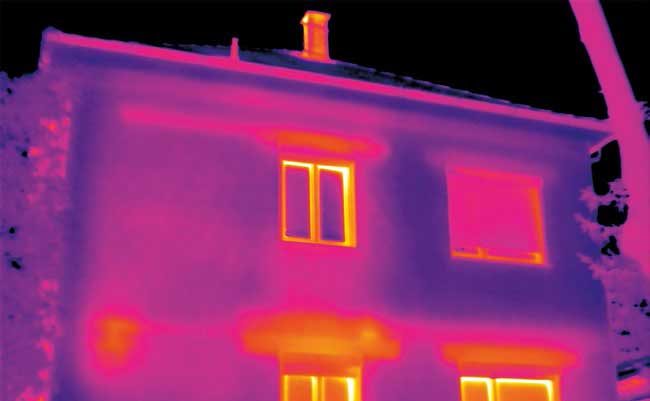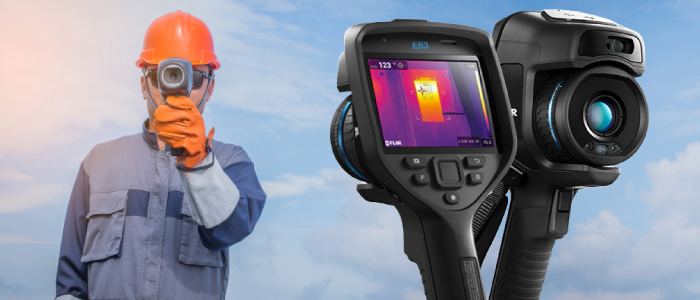One of the quickest ways to assess the performance of building insulation and identify problem areas in walls is an outdoor thermographic inspection using a thermal imaging camera. However, there are several precautions that need to be taken in order avoid inaccurate results and ensure that the observer gains as much information as possible out of the inspection.
Choosing the Right Thermal Camera
Various performance parameters must be taken into consideration when selecting a thermal imaging camera for an external thermographic inspection. It is advised that your camera has a thermal resolution of at least 160 x 120 pixels (FLIR E6-XT, Testo 868) and but preferably 320 x 240 pixels (FLIR E8-XT, Testo 872) as the nature of outdoor thermal inspections means that you will be surveying a large area at once. Similarly a large 3.5” display will allow the user to see thermographs in real time and thermal sensitivity of at least 100mK is useful for seeing hot water pipes and similar patterns behind the walls.
Weather Conditions for External Thermal Inspections
Weather conditions are very important when it comes to performing thermal inspections from outside a building as adverse conditions can completely obscure or distort thermographic information.
When assessing the effectiveness of a building’s insulation, winter is the best time for performing an inspection. A clear, cold day is ideal, as there should be a minimum 10-15˚C difference between the inside and outside of the property in the preceding 12 hours. Rain, snow and thick fog will prevent accurate inspection as will strong sunshine so it is best to do it in the early hours before the sun comes up.
There are a couple of exceptions to these rules. Firstly, surveying the external shell of a cold or cool storage facility such as a grain silo must be done in hot conditions, preferably in summer and that is also the case for timber-framed buildings as the different building materials involved cool and warm at different rates, thus allowing in-depth inspection after sunset in warm seasons.
What to Look Out For in an External Inspection
External thermal inspections are ideal for performing quick surveys of the exterior walls of a structure. This in turn gives insights into problems such as thermal bridges, air leaks, and insulation defects in the building shell, frequently shown as brighter colours in problematic areas.
See the difference between the area above the left-hand ground floor window compared to the left-hand first floor window in Fig 1 for instance. The heat loss surrounding the former is significantly greater than that of the latter. Similar patterns will show up for a range of other problems.
Figure 1:

Aside from these principal applications, the user will also be able to see hidden structural features or defects in new and old properties. An inspection may also show timber coated in mineral plaster and where plaster has become degraded. Finally, water damage may also be revealed during an inspection.
Shortcomings of External Thermal Inspections
Whilst external thermographic inspections are great for assessing the temperature conditions of a property, they do have some serious shortcoming that limit their usefulness in some circumstances.
As stated above, unlike internal inspections, external inspections are subject to weather conditions, meaning that they can only be performed at certain times of year and are always subject to late cancellations should conditions not be conducive.
Furthermore, external thermographic surveying is unsuitable for assessing roofs for the practical reason that it is difficult to get high enough to perform a proper inspection. Additionally, heat losses are released directly into the air flowing over a defect so will not show up on a thermographic survey. This is the same for ventilated façades.
Thermal Cameras from Test-Meter
We stock a wide range of thermal imaging cameras with suitable specifications for outdoor thermal imaging inspections. You can explore the whole range here.
We also offer a range of thermal cameras for hire, including both entry and high-spec models.

